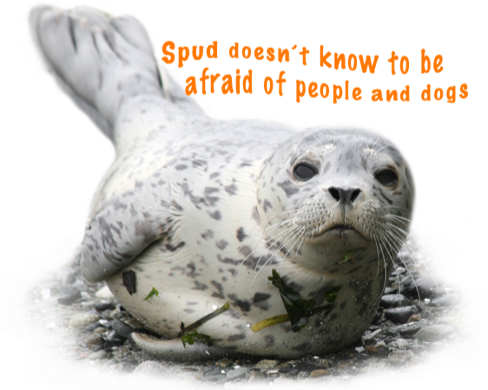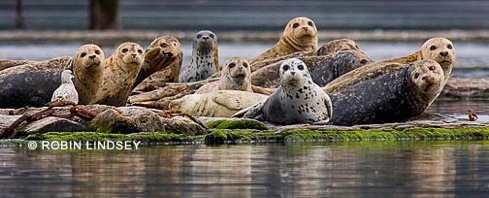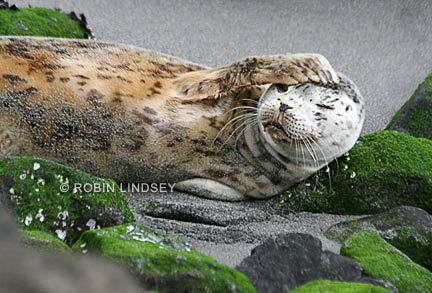

In August of 2007, a tiny seal pup appeared on busy Alki Beach and was quickly surrounded by a mob of curious and concerned beach goers. Was the pup sick? Was he abandoned? Where was mom? The people didn't know what to do!
Someone who did know said that the pup just needed to rest - so the crowd of people quietly stepped back and watched him snooze all afternoon into the evening. Nicknamed Spud (for Spud's Fish and Chips restaurant across the street from the beach), he returned every day for a week to stretch and yawn and sleep on the sandy beach. Concerned residents had consulted with NOAA (the National Oceanic and Atmospheric Association) about how to protect the pup. Yellow tape was stretched in a big half-circle around Spud. On the third day, another pup (named Neptune) flopped onshore just a few feet from Spud. Seal pups started popping up everywhere in West Seattle. What the heck was going on? Harbor seal pupping season!

In South Puget Sound where Seattle is located, harbor seal pups are born in safe places called rookeries from mid-June until the first week of September (pupping season). These rookeries, where large numbers of seals gather, are on islands, sand spits, rock jetties or logbooms - usually far away from people. Sometimes, though, a mom might give birth near an urban beach and leave her pup alone while she fishes nearby. If the pup is still nursing, the mom may not come back if too many people or dogs are around. Since the pup can't fish on his own yet, he can't survive without her milk for nourishment. Most often, though, the pup accompanies mom while she teaches her little one how to catch shiny, fast fish.
After 4-6 weeks of nursing on her rich milk and learning how to hunt, the pup is weaned. At the end of the season, the adults are grumpy because they are molting their fur (that means shedding - just like your cat or dog, except seals grow a brand new silky coat every year). That's the time when pups leave their rookery home and swim off on new adventures. In human years, you would be on your own at only 7 years old! Can you imagine trying to survive without your mom or dad? This is when people often see pups alone on the beach and think something is wrong. Now you know that they are resting and warming up. Like all harbor seals, they spend 50% of their time on shore. Remember, if you see a pup on the beach, always keep your distance and observe quietly. Use your binoculars to get a closer look!

That late summer and fall of 2007, the volunteers who came to be known as Seal Sitters looked after many fat little seal pups. Robin Lindsey, a photographer and co-founder of the group (with author Brenda Peterson), spent every morning at sunrise scouring the beaches, hoping to find the pups before people and dogs scared them back into Puget Sound.
One morning, she noticed a line of tracks in the sand leading into the rocks below the sea wall. She could see two golden flippers peeking out. Soon, the pup stirred around and a little head poked up from the mossy rocks. She nicknamed the pup Leopard for his golden coat and black spots. Each morning at sunrise, she watched Leopard haul out of the cold blue water and flop across the beach into his secret hideaway. Early one morning, another little pup was sleeping with Leopard, her head resting on his chubby belly. They became fast friends and everywhere Silkie went, Leopard followed - like a kid brother or sister. Excited volunteers stretched protected marine mammal tape around them and educated people that seal pups need to rest and warm up.